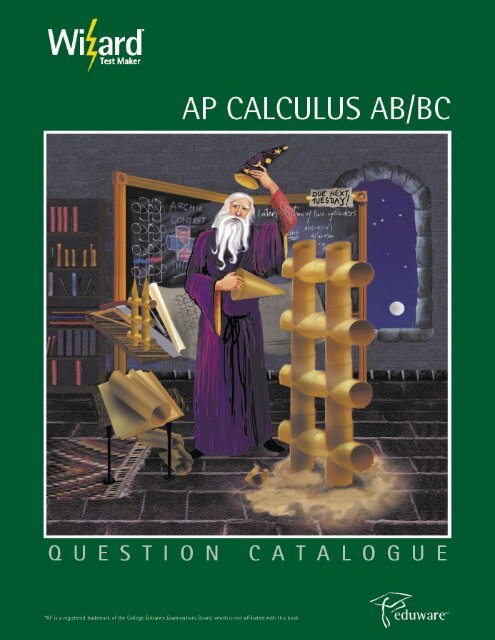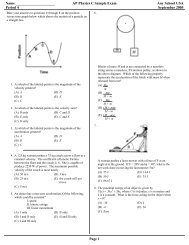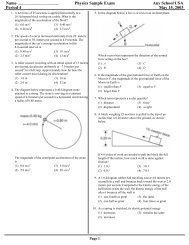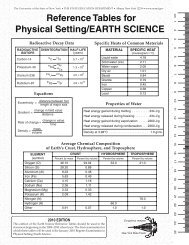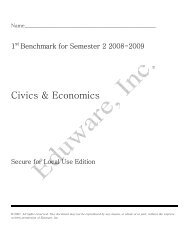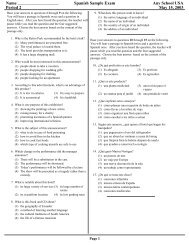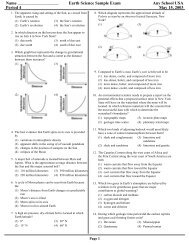AP Calculus - Eduware
AP Calculus - Eduware
AP Calculus - Eduware
You also want an ePaper? Increase the reach of your titles
YUMPU automatically turns print PDFs into web optimized ePapers that Google loves.
<strong>AP</strong> <strong>Calculus</strong><br />
Table of Contents<br />
I. FUNCTIONS, GR<strong>AP</strong>HS AND LIMITS<br />
1. Functions<br />
A. Rational Functions……………………………………………..………………1<br />
B. Trigonometric Functions……………………………………………..………2<br />
C. Exponential and Logarithmic Functions………………………….……… 3<br />
D. Inverse Functions…………………………………………………..………… 4<br />
E. Parametric Functions…………………………………….…………………..…4<br />
2. Limits and Continuity<br />
A. Definitions……………………………………………………………..…………5<br />
B. Asymptotes……………………………………………………………..………10<br />
C. Finding Limits Algebraically…………………………………………..………11<br />
D. Infinite Limits……………………………………………………………..…… 16<br />
3. Part 2 Questions……………………………………………………………………..………18<br />
II. DERIVATIVES<br />
1. Definitions<br />
A. Geometric Definition……………………………………………………………23<br />
B. Analytic Definition……………………………………………………………..26<br />
2. Basic Differentiation<br />
A. The Power Rule……………………………………………………………… 29<br />
B. Trigonometric Derivatives……………………………………………………32<br />
C. The Product Rule………………………………………………………………34<br />
D. The Quotient Rule………………………………………………………………36<br />
E. The Chain Rule………………………………………………………….………39<br />
F. Exponential Derivatives……………………………………………………… 45<br />
G. Logarithmic Derivatives………………………………………………………48<br />
3. Advanced Differentiation<br />
A. Implicit Differentiation…………………………………………………………51<br />
B. Inverse Functions………………………………………………………………55<br />
C. L'Hopital's Rule…………………………………………………………………57<br />
D. Parametric Derivatives…………………………………………………………61<br />
E. Polar Derivatives……………………………………………………………… 64<br />
F. Vector Derivatives………………………………………………………………65<br />
4. Applications<br />
A. Tangent and Normal Lines……………………………………………………65<br />
B. Motion……………………………………………………………………………69<br />
C. Related Rates……………………………………………………………………73<br />
D. Maximum, Minimum and Inflection Point………………………………… 77<br />
E. Optimization………………………………………………………………………81<br />
F. Rolle's Theorem…………………………………………………………………84<br />
G. Mean-Value Theorem………………………………………………………… 85<br />
H. Tangent Line Approximation…………………………………………………87
5. Part 2 Questions……………………………………………………………………………89<br />
III. INTEGRALS<br />
1. Antiderivatives<br />
A. Basic Antiderivatives………………………………………………………… 113<br />
B. Inverse Trigonometric Functions……………………………………………117<br />
C. U-Substitution……………………………………………………………………119<br />
2. Definite Integrals<br />
A. Riemann Sums………………………………………………………………… 131<br />
B. Fundamental Theorem of <strong>Calculus</strong>…………………………………………135<br />
C. Average Value……………………………………………………………………137<br />
D. Definite Integrals……………………………………………………………… 138<br />
3. Advanced Methods of Integration<br />
A. Integration by Parts……………………………………………………………142<br />
B. Integration by Partial Fractions………………………………………………146<br />
C. Improper Integrals…………………………………………………………… 150<br />
4. Applications<br />
A. Area……………………………………………………………………………… 153<br />
B. Volumes………………………………………………………………………… 157<br />
C. Differential Equations…………………………………………………………163<br />
D. Euler's Method………………………………………………………………… 172<br />
E. Arc Length……………………………………………………………………… 173<br />
F. Motion…………………………………………………………………………… 176<br />
G. Parametric Functions…………………………………………………………181<br />
H. Polar Curves…………………………………………………………………… 182<br />
5. Part 2 Questions……………………………………………………………………………184<br />
IV. POLYNOMIAL <strong>AP</strong>PROXIMATIONS AND SERIES<br />
1. Series of Constants<br />
A. Convergence and Divergence……………………………………………… 209<br />
B. Alternating Series………………………………………………………………216<br />
C. Sums of Series………………………………………………………………… 217<br />
2. Taylor Series…………………………………………………………………………………219<br />
3. Part 2 Questions……………………………………………………………………………223
I. FUNCTIONS, GR<strong>AP</strong>HS AND LIMITS A. Rational Functions<br />
1. Functions 1. Rational Functions<br />
1071.<br />
1218.<br />
(A)(–4, 4) (D)(–!, !)<br />
(B) x # –3, –4 (E) x # –4, 4<br />
(C) x # –3, –4, 4<br />
1097.<br />
(A)x & 0 (D)x & 4<br />
(B) x > 4 (E) x % 4<br />
(C)x < 4<br />
The graph of y 2 –5y – 1 = x 2 is a(n)<br />
1168. (A)circle<br />
(D)line<br />
(B) ellipse<br />
(E) parabola<br />
(C)hyperbola<br />
If the zeros of f (x) are x = –2 and x = 3, then<br />
1215. the zeros of f ( x<br />
2 ) are x =<br />
(A)–1, 3<br />
2 (D)–3, 9<br />
2<br />
(B) –2, 3 (E) –4, 6<br />
(C) –2, 6<br />
If f (x) = 3 – x and g (x) = `•5, then f (g (–2)) =<br />
1244. (A)0<br />
(D)`2<br />
(B) 4 ‚`7<br />
(E) Undefined<br />
(C) `7<br />
1524.<br />
1582.<br />
(A)–15<br />
(D)7<br />
(B) –4 (E) 15<br />
(C) 6<br />
1525.<br />
Which of the following functions is represented<br />
by the graph above?<br />
(A)<br />
(D)<br />
(B)<br />
(C)<br />
(E)<br />
(A)g (x) = 1 (D)g (x) = 0<br />
(B) g (x) is negative (E) f (x) = g (x)<br />
(C) f (x) = 0<br />
A polynomial has a relative maximum at (–5, 4),<br />
1726. a relative minimum at (1, –7) and a relative<br />
maximum at (4, 2), and no other critical points.<br />
How many real roots does the polynomial have?<br />
(A)2<br />
(D)5<br />
(B) 3 (E) 6<br />
(C)4<br />
(A) 3<br />
7 (D) 12<br />
7<br />
(B) 2<br />
3 (E) 14<br />
7<br />
(C) 12<br />
3<br />
© EDUWARE 2005 1
II. DERIVATIVES<br />
A. Geometric Definition<br />
1. Definitions 1. Geometric Definition<br />
If the graph of f (x) is symmetric with respect to<br />
1570. the line y = x and is differentiable everywhere,<br />
then the graph of f'(x) is<br />
(A)Symmetric with respect to the line y = 0<br />
(B) Symmetric with respect to the line x = 0<br />
(C) A parabola<br />
(D)A hyperbola<br />
(E) None of the above<br />
If f (x) is a continuous differentiable function and<br />
1503. f ' (a) = 0, what can always be said about the<br />
graph of f (x) at a?<br />
Where is f '(x) < 0?<br />
1240. (A)(0, 1) and (2, !) (D)(–!, 0) and (1, 2)<br />
(B) (‚¡, 3) (E) (‚!, ‚¡) and (¦,<br />
!)<br />
(C) (!, 0) and (1, 2)<br />
Where is f '(x) > 0?<br />
1239. (A)(!, 0) and (1, 2)<br />
(D)(‚!, ‚¡) and<br />
(3, 0)<br />
(B) (0, 1) and (2, !) (E) (‚!, ‚¡) and (¦,<br />
!)<br />
(C) (0, 3)<br />
I. The line tangent to the curve at a is<br />
horizontal.<br />
II. The curve is at a local maximum or<br />
minimum<br />
III. There is an inflection point at a.<br />
(A)I only<br />
(D)II only<br />
(B) I and II<br />
(E) III only<br />
(C) II and III<br />
Where is f '(x) = 0?<br />
1238. (A)x = 1 (D)x = 0 and x = 2<br />
(B) x = 2 (E) x = 0, x = 1, x = 2<br />
(C) x = 0<br />
Base your answers to questions 607 through 605 on<br />
the graph below of f (x).<br />
Base your answers to questions 1241 through 1238 on<br />
the graph below of f (x).<br />
Where is f '(x) undefined?<br />
1241. (A)x = 1<br />
(D)All of the above<br />
(B) x = 2<br />
(E) None of the above<br />
(C) x = 0<br />
607. At which point is f '(x) = 0 and f ''(x) > 0?<br />
(A)A<br />
(D)D<br />
(B) B<br />
(E) E<br />
(C) C<br />
606. At which point is f '(x) < 0 and f ''(x) = 0?<br />
(A)A<br />
(D)D<br />
(B) B<br />
(E) E<br />
(C)C<br />
24 © EDUWARE 2005
II. DERIVATIVES<br />
A. Tangent and Normal Lines<br />
4. Applications 1. Tangent and Normal Lines<br />
There are two lines through the point (1, –2) that<br />
1827. are tangential to the parabola y = x 2 + 2. Find the<br />
x–coordinates of these points of intersection.<br />
(A)x = –0.873, 6.873 (D)x = –0.765, 1.459<br />
(B) x = –1.236, 3.236 (E) x = –1.427, 3.683<br />
(C) x = –2.327, 3.327<br />
If 2x –5y = 23 is the equation of the line normal<br />
1722. to the graph of f at the point (14, 1), then<br />
f'(14) =<br />
(A) 2<br />
5<br />
(D)–5<br />
(B) 5<br />
2 (E) – 5<br />
2<br />
(C) – 2<br />
5<br />
The line tangent to the graph of y = –x –2 at the<br />
1662. point (1, –1) intersects both x and y axes. What is<br />
the area of the triangle formed by this tangent<br />
line and coordinate axes?<br />
(A)1<br />
(D)3.5<br />
(B) 2 (E) 0.75<br />
(C)2.25<br />
The equation of the normal line to the curve<br />
1658. y =3x 2 –2x at x = 1 is<br />
(A)y = x<br />
4 + 5<br />
4 (D)y =4x – 3<br />
(B) y = x<br />
4 + 3<br />
4 (E) None of the above<br />
(C)y = – x<br />
4 + 5<br />
4<br />
What is the slope of the line tangent to the curve<br />
1646. x 2 + y 2 = 9 when x = 3?<br />
(A)–1<br />
(D)p<br />
(B) 0<br />
(E) Infinite slope<br />
(C) 1<br />
What is the length of the chord of the circle<br />
1645. x 2 + y 2 = 9 formed by the line normal to the<br />
circle at x = 3<br />
2 ?<br />
(A)3<br />
(D)12<br />
(B) 6<br />
(E) `3<br />
(C) 9<br />
What is the slope of the line tangent to the curve<br />
1580. y = e x at x = e.<br />
(A)e p<br />
(D)e e<br />
(B) 1<br />
(C) e<br />
(E) e x<br />
Find the equation to the line tangent to the polar<br />
1579. curve r = 2cos (¡‡) at (0, `2).<br />
(A)y =–x + `2 (D)y = – ¡x<br />
(B) y = – ¡x + `2<br />
(C) y = `2<br />
(E) y =–2x<br />
Find the equation of the line normal to the curve<br />
1506. x 2 + y 2 5π<br />
= 1 at (cos 5π 4 , sin 4 ).<br />
(A)y = x<br />
(D)y =–2x<br />
(B) y =–x (E) y =–x – 2<br />
(C) y =2x<br />
Which of the following is the equation of the line<br />
1499. tangent to the curve f (x) = 2 sin (x) at x = p.<br />
(A)y =–2x +2p (D) y<br />
2 = x + p<br />
(B) y<br />
2 =–x – p (E) None of the above<br />
(C) y =2x –2p<br />
The tangent line to the curve y = x 3 –2x + 4 at<br />
1485. the point (0,4) has an x–intercept at<br />
(A)(0, 0) (D)(3, 0)<br />
(B) (–2, 0) (E) (–3, 0)<br />
(C)(2, 0)<br />
If f (x) = 3x 2 – 5, what is the equation for the<br />
1039. tangent line to the curve when x = 1?<br />
(A)y + 2 = 6(x – 1) (D)y – 2 = 6(x + 1)<br />
(B) y – 2 = –12(x – 1) (E) y =6x<br />
(C) y – 2 = 6(x – 1)<br />
982. If f (x) = 2x 3 –4x 2 –6x + 1, then the equation for<br />
the normal line to the curve perpendicular to<br />
y + 3 = 2(x – 1) is<br />
(A)y +2x + 15 = 0 (D)2y – x + 15 = 0<br />
(B) y +2x – 15 = 0 (E) 2y + x + 15 = 0<br />
(C)y –2x + 15 = 0<br />
66 © EDUWARE 2005
II. DERIVATIVES<br />
B. Motion<br />
4. Applications 1. Motion<br />
Base your answers to questions 586 through 584 on<br />
the graph below, which shows the velocity of an<br />
object moving along a straight line during the time<br />
interval 0 % t % 7.<br />
Base your answers to questions 504 through 500 on<br />
the information below.<br />
A particle moves along a horizontal line and its<br />
position at time t is s = ¡t 4 –2t 3 +2t 2 +5.<br />
504. The position of the particle is always increasing<br />
for<br />
(A)t > 0 (D)t < 0<br />
(B) t > 1 (E) 0 < t < 2<br />
(C)t > 2<br />
502. The velocity is increasing when<br />
(A)t < 0<br />
(B) t > 2<br />
(C) 0 < t < 1 or t > 2<br />
(D)<br />
586. At what time(s) does the object change<br />
direction?<br />
(A)t = 3 and t = 5 (D)t = 6<br />
(B) t = 5 and t = 6 (E) t = 5<br />
(C)t = 3<br />
584. At what time(s) does the object reach its<br />
maximum acceleration?<br />
(A)1 < t < 5 (D)t = 6<br />
(B) 0 < t < 2 (E) t = 5<br />
(C) t = 3<br />
519. The displacement from the origin of a particle<br />
moving on a line is given by s = t 4 –2t 3 . The<br />
maximum displacement during the time interval<br />
–1 % t % 3 is approximately<br />
(A)13.966<br />
(D)18<br />
(B) 18.685 (E) 34.604<br />
(C) 27.000<br />
(E)<br />
500. The particle is at rest when t is equal to<br />
(A)0 (D)0 and 2<br />
(B) 1 and 2 (E) 0, 1, and 2<br />
(C) 0 and 1<br />
Base your answers to questions 499 through 496 on<br />
the information below.<br />
The position of a particle moving along a straight line<br />
is given by s = t 3 –9t 2 +24t – 6.<br />
499. The speed of the particle is decreasing for<br />
(A)t < 1 (D)t < 1 and t > 2<br />
(B) t > 2<br />
(E) all t<br />
(C)t < 3<br />
498. The acceleration is positive<br />
(A)when t < 3 (D)for 2 < t < 4<br />
(B) when t > 3 (E) for all t, t # 3<br />
(C) for 2 < t < 3<br />
© EDUWARE 2005 71
II. DERIVATIVES<br />
C. Related Rates<br />
4. Applications 1. Related Rates<br />
775. The sides of an equilateral triangle are increasing<br />
at the rate of 12 in/sec. How fast is the triangle’s<br />
area increasing when the sides of the triangle are<br />
each 2 inches long?<br />
(A)6`3 ft/sec<br />
(D)36`3 ft/sec<br />
(B) 12`3 ft/sec (E) 48`3 ft/sec<br />
(C) 24`3 ft/sec<br />
740. A boat is being pulled toward a dock by a rope<br />
attached to its bow through a pulley on the dock<br />
3 feet above the bow. If the rope is hauled in at a<br />
rate of 5 ft/sec, how fast is the boat approaching<br />
the dock when its 4 feet from the dock?<br />
(A)2 ft/sec<br />
(D)5 ft/sec<br />
(B) 3 ft/sec<br />
(E) 6 ft/sec<br />
(C)4 ft/sec<br />
553. An inverted circular cone with its vertex down<br />
has a depth of 10 in and a radius at the top of<br />
4 in. Water is leaking out so that the water level<br />
is falling at the rate of 1 in/hr. How fast the water<br />
leaking out of the cone when the water is 6 in<br />
deep?<br />
(A)1.92p in 3 /hr (D)3.8p in 3 /hr<br />
(B) 2.4p in 3 /hr (E) 5.76p in 3 /hr<br />
(C) 3p in 3 /hr<br />
551. A spherical balloon is being filled with helium at<br />
the rate of 9 ft 3 /min. How fast is the surface area<br />
increasing when the volume is 36p ft 3 ?<br />
(A)2 ft 2 /min<br />
(D)3p ft 2 /min<br />
(B) 2p ft 2 /min<br />
(E) 6 ft 2 /min<br />
(C) 3 ft 2 /min<br />
716. An inverted conical container has a diameter of<br />
36 in and a depth of 12 in. If water is flowing<br />
out of the vertex of the container at a rate of<br />
15p in 3 /sec, how fast is the depth of the water<br />
dropping when the height his 3 inches?<br />
(A) 15<br />
20<br />
2 in/s (D) 27 in/s<br />
(B) 15<br />
20<br />
4 in/s (E) 27 p in/s<br />
(C) 10<br />
9 in/s<br />
9<br />
597. A foot tall rectangular box’s length is increasing<br />
at the rate of 0.25 feet/sec and its width is<br />
decreasing at 0.5 feet/sec. When the length is<br />
0.8 feet and its width is 1 foot, the volume of the<br />
box is changing at<br />
(A)–0.25 ft 3 /sec (D)0.25 ft 3 /sec<br />
(B) –0.15 ft 3 /sec (E) 0.4 ft 3 /sec<br />
(C) 0.15 ft 3 /sec<br />
555. The height (h) and radius (r) of a cylinder both<br />
increase at the rate of 1 in/sec. How fast does<br />
the surface area increase?<br />
(A)2p (r + h)<br />
(D)4pr + 2ph<br />
(B) 2p (3r + h) (E) 4pr<br />
(C) 6pr<br />
470. A 5-foot-tall person is walking at a rate of<br />
3 ft/sec away from a street lamp that is 16 feet<br />
tall. How fast is the length of her shadow<br />
changing?<br />
(A) 3<br />
11 ft/sec (D)11 ft/sec<br />
(B) 15<br />
11 ft/sec (E) 15 ft/sec<br />
(C) 3 ft/sec<br />
468. Milk spilled from a carton spreads in a circle<br />
whose circumference increases at a rate of<br />
20 ft/sec. How fast is the area of the spill<br />
increasing when the circumference of the circle<br />
is 81p ft?<br />
(A)810 ft 2 /sec (D)180 ft 2 /sec<br />
(B) 360 ft 2 /sec (E) 90 ft 2 /sec<br />
(C) 270 ft 2 /sec<br />
212. [Calculator] The best approximation to the<br />
increase in volume of a sphere when the radius is<br />
increased from 2 to 2.1 is<br />
(A)9<br />
(D)6<br />
(B) 8 (E) 5<br />
(C) 7<br />
76 © EDUWARE 2005
II. DERIVATIVES<br />
D. Maximum, Minimum and Inflection Point<br />
4. Applications 1. Maximum, Minimum and Inflection Point<br />
Base your answers to questions 538 through 537 on<br />
the graph below of f ' (x).<br />
Base your answers to questions 320 through 318 on<br />
the graph below of f ' (x).<br />
538. f has a point of inflection at x =<br />
(A)0.5 (D)0.5 and 3<br />
(B) 3 (E) 1 and 5<br />
(C) 5<br />
537. f has a local minimum at x =<br />
(A)0<br />
(D)3<br />
(B) 0.5 (E) 5<br />
(C) 1<br />
480. On the closed interval [0, 2p], the maximum<br />
value of the function f (x) = 5sin x – 12cos x is<br />
(A)0<br />
(D)12<br />
(B) 60<br />
13 (E) 13<br />
(C) 5<br />
225. The minimum value of the slope of the curve<br />
y = x 6 – x 4 +3x is<br />
(A)–3.025<br />
(D)2.595<br />
(B) –2.595 (E) 3.025<br />
(C) 0<br />
215. If f is differentiable and difference quotients<br />
underestimate the slope of f at x = a for all h > 0,<br />
which of the following must be true?<br />
(A)f '' < 0 (D)f '' > 0<br />
(B) f ' < 0<br />
(E) None of the above<br />
(C) f ' > 0<br />
320. The function is concave downward for which<br />
interval?<br />
(A)(1, 2) (D)(–1, 1)<br />
(B) (1, 4) (E) (–1, 4)<br />
(C) (2, 3)<br />
319. Which statement best describes f at x = 0?<br />
(A)f is a minimum<br />
(B) f is a maximum<br />
(C) f has a root<br />
(D)f has a point of inflection<br />
(E) None of the above<br />
318. Which of the following is true based upon the<br />
graph above?<br />
(A)f has a local maximum at x = 0<br />
(B) f has a local maximum at x = –1<br />
(C) f is a constant for 1 < x < 4<br />
(D)f is decreasing for –1 < x < 1<br />
(E) f is discontinuous at x = 1<br />
151. The number of inflection points of<br />
f (x) = 4x 4 –4x 2 is<br />
(A)0<br />
(D)3<br />
(B) 1 (E) 4<br />
(C)2<br />
80 © EDUWARE 2005
II. DERIVATIVES<br />
A. Part 2 Questions<br />
5. Part 2 Questions 1. Part 2 Questions<br />
Given the function f (x) = e –x (x 2 + 1)<br />
1271. (a) For what values if f increasing?<br />
(b) For what values is f concave up?<br />
(c) Set up, but do not evaluate an integral (or set<br />
of integrals) which give the arc length of the<br />
segment of f from x = 0 to x = 1.<br />
A particle moves along the x-axis in such a way<br />
1266. that its acceleration at time t for t & 0 is given by<br />
a(t) = 6sin(3t). At time t = 0, the velocity of the<br />
particle is v(0) = `2 and its position is x(0) = 0.<br />
(a) Write an equation for the velocity v(t) of the<br />
particle.<br />
(b) Write an equation for the position x(t) of the<br />
particle.<br />
(a) v(t) = –2cos (3t) + `2 + 2<br />
(b) x(t) = – ¤sin (3t) + t`2 +2t<br />
1268.<br />
A particle moves along the x-axis so that its<br />
1265. velocity at any time t & 0 is given by<br />
v(t) = 1 – 2 cos p t.<br />
(a) Find the acceleration a(t) of the particle at<br />
any time t.<br />
(b) Find all values of t, 0 % t % 4, for which the<br />
particle is at rest.<br />
(c) Find the position x(t) of the particle at any<br />
time t if x(0) = 0.<br />
The figure above shows the graph of f ', the<br />
derivative of a function f. The domain of f is the<br />
set of all real numbers x such that –6 % x % 6.<br />
(a) For what values of x does the graph of f have<br />
a horizontal tangent?<br />
(b) For what values of x in the interval –6 < x <<br />
6 does f have a relative minimum? Justify your<br />
answer.<br />
(c) For what values of x is the graph of f concave<br />
upward?<br />
(a) x = – 11<br />
2 , –2, 0, 2, 9<br />
2<br />
11<br />
(b) x = – 2 , 0, 9<br />
2<br />
7<br />
(c) x < – 2 or – 1<br />
2 < x < 1 or x > 3<br />
Let f be a differentiable function, defined for all<br />
1217. real x, with the following properties:<br />
1) f" (1) = f' (1) = f (1)<br />
2) f is a polynomial of degree at most 2<br />
3) f has only one fixed point (that is, there is<br />
exactly one p such that f (p) = p.<br />
Find f (x).<br />
f (x) = 0<br />
Let f (x) = 8 – 2x 2 for x & 0 and f (x) & 0.<br />
1264.<br />
(a) The line tangent to the graph of f at the point<br />
(x, y) intercepts the x-axis at x = 3. What are the<br />
coordinates of the point (x, y)?<br />
(b) An isosceles triangle whose base is the<br />
interval from (0, 0) to (k, 0) has its vertex on the<br />
graph of f. For what value of k does the triangle<br />
have maximum area? Justify your answer.<br />
108 © EDUWARE 2005
III. INTEGRALS<br />
A. Riemann Sums<br />
2. Definite Integrals 1. Riemann Sums<br />
729. Using a right Riemann sum, what is the area<br />
under the curve y = x 2 + x from x = 0 to x = 3<br />
when n = 6?<br />
(A)10.625<br />
(D)13.625<br />
(B) 13.438 (E) 16.625<br />
(C) 13.500<br />
658. What is an approximation for the area under the<br />
curve y =4x – x 2 on the interval [0, 4] using the<br />
midpoint formula with 20 subintervals?<br />
(A)10.589<br />
(D)10.681<br />
(B) 10.624 (E) 10.703<br />
(C) 10.667<br />
723. Using the Trapezoidal Rule, what is the area<br />
under the curve y = x 2 + x from x = 0 to x = 3<br />
when n = 6?<br />
(A)10.625<br />
(D)13.625<br />
(B) 13.438 (E) 16.625<br />
(C) 13.500<br />
703. A Riemann sum to calculate the area under f (x)<br />
on the interval a % x % b with an infinite number<br />
of subintervals will yield the value<br />
(A)<br />
(D)<br />
657. What is an approximation for the area under the<br />
curve y = É on the interval [2, 5] using the<br />
trapezoidal rule with 9 subintervals?<br />
(A)0/868<br />
(D)0.918<br />
(B) 0.915 (E) 0.968<br />
(C) 0.916<br />
654.<br />
(B)<br />
(C)<br />
(E)<br />
651.<br />
(A)2.932<br />
(D)3.750<br />
(B) 3.742 (E) 4.552<br />
(C) 3.747<br />
694. Using the Midpoint Formula, what is the area<br />
under the curve y = x 2 + x from x = 0 to x = 3<br />
when n = 6?<br />
(A)10.625<br />
(D)13.625<br />
(B) 13.438 (E) 16.625<br />
(C) 13.500<br />
682. Using a right Riemann sum, what is the area<br />
under the curve y =2x – x 2 from x = 1 to x = 2<br />
when n = 4?<br />
(A)0.53125<br />
(D)0.67187<br />
(B) 0.65625 (E) 0.78125<br />
(C) 0.66667<br />
(A)11.992<br />
(D)17.059<br />
(B) 16.155 (E) 22.126<br />
(C) 16.456<br />
647. Using a left Reimann sum, what is the area under<br />
the curve y = `• from x = 1 to x = 3 when n =4?<br />
(A)2.976<br />
(D)2.793<br />
(B) 2.800 (E) 2.610<br />
(C) 2.797<br />
460. Using a left Riemann sum, what is the area under<br />
the curve y =2x – x 3 from x = 1 to x = 2 when<br />
n = 4?<br />
(A)0.53125<br />
(D)0.67187<br />
(B) 0.65625 (E) 0.78125<br />
(C) 0.66667<br />
134 © EDUWARE 2005
III. INTEGRALS<br />
A. Area<br />
4. Applications 1. Area<br />
1851.<br />
1674.<br />
(A)16<br />
(D)23.5<br />
(B) 22 (E) 31<br />
(C) 22.5<br />
Find the area in the first quadrant bounded by the<br />
1795. graphs of y = cot x , y = 2sin x and the x–axis.<br />
(A)0.438<br />
(D)0.909<br />
(B) 0.470 (E) 1.571<br />
(C) 0.746<br />
(A)e 2 – 1<br />
(D)e<br />
(B) e – 1 (E) e 3 (1 – e)<br />
(C) e 2 –e<br />
Let f (x) = xsin (x – p), 0 < x
III. INTEGRALS<br />
B. Volumes<br />
4. Applications 1. Volumes<br />
The base of a solid is the region bounded by the<br />
1670. line –y + 6 = 2x and the coordinate axes. What is<br />
the volume of the solid generated if every cross<br />
section perpendicular to the x–axis is a<br />
semicircle?<br />
(A) 7<br />
2 p (D)14p<br />
(B) 9<br />
2<br />
p (E) 18p<br />
(C) 9p<br />
The region bounded by the graphs of y = 3 – e –x<br />
1661. and y = x 2 is revolved around the x–axis. The<br />
volume of the resulting solid is<br />
(A)9.805<br />
(D)27.362<br />
(B) 11.473 (E) 30.805<br />
(C) 19.975<br />
What is the volume of the solid when the region<br />
1141. bounded by xy = 6 and x + y = 5 is revolved<br />
about the x-axis?<br />
(A)p (D) 1<br />
6 p<br />
(B) 2<br />
3 p (E) 1<br />
9 p<br />
(C) 1<br />
3 p<br />
What is the volume of the solid when the region<br />
1100. bounded by y = x<br />
3 , y = x, y = 1 and y = 2 is<br />
revolved about the x-axis?<br />
(A)8p<br />
(D)12p<br />
(B) 28<br />
40<br />
3<br />
p (E) 3 p<br />
(C) 32<br />
3 p<br />
966. What is the volume of the solid when the region<br />
bounded by y = x 3/2 , x = 0, x = 4 and y = 0 is<br />
revolved about the x-axis?<br />
(A)1028p (D) 64<br />
5<br />
(B) 64p (E) 256<br />
55 p`2<br />
(C) 3p<br />
941. What is the volume of the solid that has a<br />
circular base of radius r and every plane section<br />
perpendicular to a diameter is semi–circle?<br />
(A) 1<br />
2 pr3 (D) 1<br />
3 r3<br />
(B) 1<br />
4 pr3 (E) 2<br />
3 r3<br />
(C) 1<br />
3 pr3<br />
940. What is the volume of the solid that has a<br />
circular base of radius r and every plane section<br />
perpendicular to a diameter is an isosceles<br />
triangle?<br />
(A) 1<br />
2 pr3 (D) 4<br />
3 r3<br />
(B) 2<br />
3 r3 (E) 2<br />
3 pr3<br />
(C) pr 3<br />
939. What is the volume of the solid that has a<br />
circular base of radius r and every plane section<br />
perpendicular to a diameter is an equilateral<br />
triangle?<br />
(A)r 3`3<br />
(D) 4`3<br />
33 r3<br />
(B) 2r 3`3<br />
(E) 8`3<br />
33 r3<br />
(C) 4r 3`3<br />
What is the volume of the solid when the region<br />
p<br />
1076. bounded by y = cos x, x = 2 and y = 0 is<br />
revolved about the y-axis?<br />
(A)1 (D) 1<br />
2 p –1<br />
(B) p<br />
(E) 1 – 2p<br />
(C) 2p<br />
What is the volume of the solid when the region<br />
1030. bounded by x = `3˜–, x = 0 and y = 6 is<br />
revolved about the y-axis?<br />
(A) 27<br />
81<br />
2 p (D) 2 p<br />
(B) 54p – p`3 (E) 6p<br />
(C) 4p`6 –2p`3<br />
922. What is the volume of the solid when the region<br />
bounded by y = `•, y = x is revolved about the<br />
x-axis?<br />
(A)p (D) 1<br />
3 p<br />
(B) 2p (E) 1<br />
6 p<br />
(C) 1<br />
2 p<br />
917. What is the volume of the solid that has a<br />
circular base of radius r and every plane section<br />
perpendicular to a diameter is a square?<br />
(A)2pr 3 (D) 8<br />
3 pr3<br />
(B) 4pr 3 (E) 16<br />
3 r3<br />
(C) 8<br />
3 r3<br />
158 © EDUWARE 2005
III. INTEGRALS<br />
C. Differential Equations<br />
4. Applications 1. Differential Equations<br />
If the population of a city increases continuously<br />
1046. at a rate proportional to the population at that<br />
time and the population doubles in 20 years, then<br />
what is the ratio of the population after 60 years<br />
to the initial population?<br />
(A)3:1<br />
(D)9:2<br />
(B) 3:2 (E) 9:4<br />
(C)9:1<br />
1027.<br />
(A)<br />
(B)<br />
(D)<br />
(E)<br />
Which of the following curves passes through<br />
1043. the point (1,1) and whose slope at any point is<br />
equal to y 2 x?<br />
(A)<br />
(D)<br />
(C)<br />
(B)<br />
(C)<br />
(E)<br />
1023.<br />
(A)y =ln|Ê| +2 (D)y = ¡ln|x| +2<br />
(B) y =ln|°| +2 (E) y =ln|x| +2<br />
(C) y = 2ln|x| +2<br />
The general solution to the differential equation<br />
1033. dy/dx = 2 is a family of<br />
(A)parabolas<br />
(D)ellipses<br />
(B) straight lines (E) circles<br />
(C) hyperbolas<br />
The general solution to the differential equation<br />
1032. dy/dx = x is a family of<br />
(A)parabolas (D)ellipses<br />
(B) straight lines (E) circles<br />
(C) hyperbolas<br />
1022.<br />
(A)<br />
(B)<br />
(C)<br />
(D)<br />
(E)<br />
1029.<br />
(A)y = cos –1 (sin x + 2) (D)y = cos –1 (sin x)<br />
(B) y = sin –1 (2 – cos x) (E) y = sin –1 (cos x)<br />
(C) y = sin –1 (cos x + 2)<br />
What is a solution to the differential equation<br />
1014. ydy =2xdx?<br />
(A)x 2 + y 2 = 4 (D)x 2 =2 –y 2<br />
(B) y 2 = x 2 (E) x 2 – y 2 = 2<br />
(C)y 2 –2x 2 = 0<br />
965. A growth rate of 5% per year is equal to a<br />
continuous growth rate of<br />
(A)ln(0.95)<br />
(D)0.95ln(1.05)<br />
(B) ln(1.05)<br />
(E) ln(1.05) – ln(0.95)<br />
(C) 1.05ln(0.05)<br />
168 © EDUWARE 2005
III. INTEGRALS<br />
F. Motion<br />
4. Applications 1. Motion<br />
A particle moves along a curve so that at any<br />
1779. time t & 0 its velocity is given by<br />
v(t) = ln (t + 1) – t 2 + 1. The total distance<br />
traveled by the particle from t = 1 to t = 3 is<br />
(A)3.986<br />
(D)4.697<br />
(B) 4.289 (E) 4.778<br />
(C) 4.508<br />
A particle travels in a straight line with a<br />
1724. constant acceleration of 2 meters per second per<br />
second (m/s 2 ). If the velocity of the particle is 5<br />
meters per second at the time t = 1 second, how<br />
far does the particle travel from t = 1 to t = 3?<br />
(A)7 m<br />
(D)11 m<br />
(B) 8 m<br />
(E) 14 m<br />
(C) 10 m<br />
A particle travels along the x–axis with velocity<br />
1718. at time t, v(t) = cos (t 2 ). If at time t = 0 the<br />
particle is at x(0) = 2, where is the particle at<br />
t = 2?<br />
(A)0.492<br />
(B) 1.529<br />
(C) 2.982<br />
(D)2.461<br />
(E) It cannot be determined from the information<br />
given.<br />
A particle moves along a path so that at any time<br />
1680. t its acceleration is given by a (t) = 2t + 1. At<br />
time t = 0, its velocity is v (0) = –6. For what<br />
value(s) of t is the particle at rest?<br />
(A)0 only (D)2 and –3<br />
(B) 2 only<br />
(E) No values<br />
(C) –3 only<br />
A particle moves along a path so that’s its<br />
1663. velocity is given by v (t) = t 2 – 4. How far does<br />
the particle travel from t = 0 to t = 4?<br />
(A) 16<br />
3 (D)16.819<br />
(B) 8 (E) 20<br />
(C)16<br />
The acceleration of a car traveling on a straight<br />
1222. track along the x-axis is given by the equation<br />
a(t)= 2t + 1, where a is in meters per second<br />
squared and t is in seconds. If at x(0) = 0 and<br />
v(0) = 0, what is its displacement at t = 3?<br />
(A)1 m<br />
(D)12 m<br />
(B) 7 m<br />
(E) 13.5 m<br />
(C) 9 m<br />
The acceleration of a car traveling on a straight<br />
1195. track along the y-axis is given by the equation<br />
a = 5, where a is in meters per second squared<br />
and t is in seconds. If at t = 0 the car’s velocity<br />
is 3 m/s, what is its velocity at t = 2?<br />
(A)5 m/s<br />
(D)13 m/s<br />
(B) 3 m/s<br />
(E) 15 m/s<br />
(C) 10 m/s<br />
The velocity of a particle is given by the<br />
1153. equation v(t) = 3t – 4. If s(0) = 2, then what is the<br />
position function of the particle?<br />
(A)s(t) = 3t 2 + 2 (D)s(t) = 3t 2 –4t + 2<br />
(B) s(t) = ¦t 2 –4t +2 (E) s(t) = t 2 –4t + 2<br />
(C) s(t) = 3<br />
The velocity of a car traveling on a straight track<br />
1091. along the y-axis is given by the equation<br />
v(t) = 12t 2 –6t + 2, where v is in meters per<br />
second and t is in seconds. The vehicle’s initial<br />
position is y = –1 m. At what time does the car<br />
pass the origin?<br />
(A)0 s<br />
(D)3 s<br />
(B) 1 s<br />
(E) 4 s<br />
(C) 2 s<br />
The equation v(t) = 3t 2 –4t + 2, where v is in<br />
1080. meters per second and t is in seconds gives the<br />
velocity of a vehicle moving along a straight<br />
track. The vehicle’s initial position is 3 meters.<br />
What distance has the vehicle traveled after 4<br />
seconds?<br />
(A)30 m<br />
(D)33 m<br />
(B) 31 m<br />
(E) 34 m<br />
(C) 32 m<br />
© EDUWARE 2005 177
III. INTEGRALS<br />
A. Part 2 Questions<br />
5. Part 2 Questions 1. Part 2 Questions<br />
For time t, 0 % t % 2p, the position of a<br />
1184. particle, is given by x = sin 2 t and y = e t cos t.<br />
Let R be enclosed by the graph of y = x ln x, the<br />
1172. line x = 2, and the x–axis.<br />
(a) Find the formula for the slope of the path of<br />
the particle as a function of time.<br />
(b) For what t is the line tangent to the curve<br />
vertical.<br />
(c) Set up an integral for the distance traveled by<br />
the particle from t = 0 to t =1.<br />
(a) Find the net area of region R.<br />
(b) Find the volume of the solid generated by<br />
revolving region R about the x–axis.<br />
(c) Set up, but do not integrate, an integral<br />
expression in terms of a single variable for the<br />
volume of the solid generated by revolving<br />
region R about the line x = 2.<br />
Let f be function given by f (x) = x 2 and let g be<br />
1183. the function given by g(x) = kx – 4, where k is a<br />
positive constant such that g is tangent to the<br />
graph of f.<br />
(a) Find the value of k.<br />
(b) Find the area bounded on top by the line<br />
perpendicular to g and on the bottom by f (x).<br />
(c) Find the volume of the solid generated by<br />
revolving the region from part (b) about the line<br />
y = 0.<br />
(a) k = 4<br />
(b) 44.667<br />
(c) 385.36<br />
Let f be a function that is defined for all real<br />
1164. numbers x and that satisfies the following<br />
properties.<br />
i. f''(x) = 10x ‚ 12<br />
ii. f'(1) = ‚16<br />
iii. f (0) = 8<br />
(a) Find all values of x such that the line tangent<br />
to the graph at (x, f (x)) is horizontal.<br />
(b) Find f (x).<br />
(c) Find the average value of f ' on the interval<br />
2 % x % 5.<br />
1315.<br />
(a) Requrite the denominator as (x 2 + 1) 2 –2x 2 .<br />
(b) Split up the denominator into a product of<br />
linear factors.<br />
(c) Integrate by partial fractions.<br />
208 © EDUWARE 2005
IV. POLYNOMIAL <strong>AP</strong>PROXIMATIONS AND SERIES<br />
A. Convergence and Divergence<br />
1. Series of Constants 1. Convergence and Divergence<br />
Which of the following series is convergent?<br />
1177.<br />
1148. (A)<br />
(D)<br />
1174.<br />
(A)convergent and decreasing<br />
(B) convergent and increasing<br />
(C) divergent and decreasing<br />
(D)divergent and increasing<br />
(E) divergent and remain the same<br />
(B)<br />
(C)<br />
(E)<br />
(A)neither increasing nor decreasing<br />
(B) decreasing and convergent<br />
(C) decreasing and divergent<br />
(D)increasing and convergent<br />
(E) increasing and divergent<br />
Which of the following infinite series has<br />
1143. increasing terms?<br />
(A)<br />
(D)<br />
Which one of the following series is divergent?<br />
1159. (A)<br />
(D)<br />
(B)<br />
(E)<br />
(B)<br />
(E)<br />
(C)<br />
(C)<br />
All of the following are examples of a geometric<br />
1142. series except<br />
(A)<br />
1158.<br />
(A)increasing and convergent<br />
(B) decreasing and convergent<br />
(C)increasing and divergent<br />
(D)decreasing and divergent<br />
(E) neither increasing or decreasing<br />
(B)<br />
(C)<br />
(D)<br />
(E)<br />
1083.<br />
(A)n & 8 (D)n % 7<br />
(B) n % 8 (E) n % 9<br />
(C) n & 7<br />
212 © EDUWARE 2005
IV. POLYNOMIAL <strong>AP</strong>PROXIMATIONS AND SERIES<br />
A. Taylor Series<br />
2. Taylor Series 1. Taylor Series<br />
Which of the following generate Taylor series?<br />
1090. (A)<br />
What is the 3 rd order Taylor polynomial at x = 0<br />
1031. for f (x) = sin x?<br />
(A)<br />
(D)<br />
(B)<br />
(C)<br />
(B)<br />
(E)<br />
(D)<br />
(E)<br />
(C)<br />
For what values of x does the following power<br />
1088. series converge?<br />
What is the 2 nd order Taylor polynomial at x = p<br />
1026. for f (x) = cos x?<br />
(A)<br />
(A)–1 < x < 1 (D)–1 < x % 1<br />
(B) –1 % x % 1 (E) x > 1 or x < 1<br />
(C)–1 % x < 1<br />
For what values of x does the following power<br />
1044. series diverge?<br />
(B)<br />
(C)<br />
(D)<br />
(A)–3 % x < 3 (D)–3 < x < 3<br />
(B) –3 % x % 3 (E) { }<br />
(C) –3 < x % 3<br />
p<br />
What is the coefficient of (x – 3 )2 in the Taylor<br />
p<br />
1024. series about 3 of f (x) = sin x?<br />
(A) 1<br />
4 (D) `3<br />
4<br />
(B) – 1<br />
4 (E) – `3<br />
4<br />
(C) 1 1<br />
3`2<br />
(E)<br />
What is an approximation for ln (0.7) using the<br />
1021. first three terms of the Taylor series<br />
f (x) = ln (1 + x) about x = 0?<br />
(A)–0.340<br />
(D)–0.355<br />
(B) –0.349 (E) –0.357<br />
(C)–0.354<br />
© EDUWARE 2005 221


